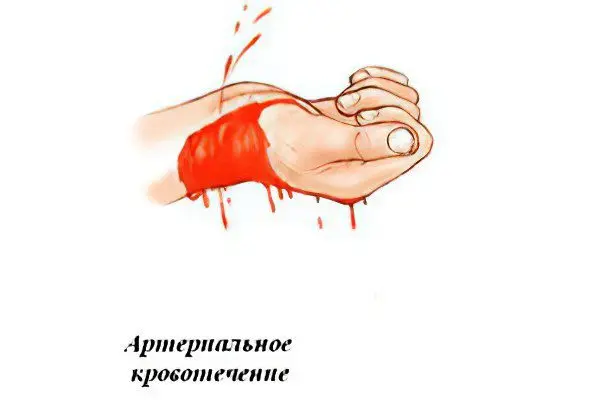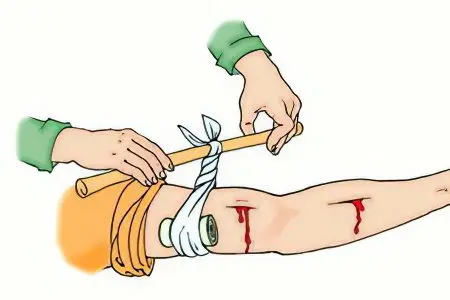Contents
Arterial bleeding is a very serious injury, which, in case of delayed medical care, can lead to death. It is considered the most dangerous of all types of bleeding. When arteries are damaged, blood flows out of them in a gushing stream.
Arterial blood is distinguished by its bright scarlet color. It flows out of the vessel in accordance with the beats of the heart. Such an injury can cause death not only immediately after it is received, but even when qualified medical care is provided. Arterial bleeding can lead to the loss of an injured limb and other complications.
Rules for stopping arterial bleeding

Blood loss during arterial bleeding occurs so rapidly that it is necessary to provide emergency assistance from the very first 2-3 minutes after its formation. When large arteries are injured, the time to provide emergency care is reduced to 1-2 minutes. Otherwise, with every second, the blood pressure will fall, as a result of which the victim will lose consciousness, fall into a coma, or die immediately.
In case of arterial bleeding, first of all, pinch (squeeze) the injury site with your fingers or fist, trying to stop the gushing flow of blood.
In this case, certain rules should be observed in pressing and squeezing certain blood vessels:
The common carotid artery is pressed with fingers to the spine, namely: to the transverse processes of the cervical vertebrae. In this case, one should press on the inner edge of the sternocleidomastoid muscle approximately in its middle part.
The external maxillary artery is pressed against the anterior edge of the masticatory muscle with fingers.
The temporal artery is compressed with fingers slightly forward from the upper edge of the ear.
The subclavian artery is pressed with fingers or a fist behind the outer edge of the clavicular part of the sternocleidomastoid muscle against the first rib.
The brachial artery is compressed by fingers along the inner edge of the biceps muscle to the bone.
The femoral artery is pressed with a fist against the pubic bone under the pupart ligament. In thin people, this vessel can be easily pressed against the thigh.
The popliteal artery is pressed down with a fist in the middle of the popliteal cavity.
After providing emergency assistance in pressing the vessel in case of damage to large arteries, it is necessary to immediately apply a rubber tourniquet to them. In case of minor bleeding, a tight roller or a single sterile bandage is bandaged to the damage. In extreme conditions, instead of a tourniquet, you can use a belt, scarf, thick rope and other improvised means with which to make a pressure bandage. A sterile bandage is applied to the wound itself to prevent infection from entering the body.
In some cases, when there is no bone fracture, forced flexion of the injured limb can be used instead of a tourniquet. With this method of stopping arterial bleeding, the injured limb is bent and fixed in a bent position with a bandage or other improvised means.
Applying a tourniquet for arterial bleeding
Already during the provision of first aid to the victim for squeezing blood vessels, one of the people around should prepare a tourniquet or improvised means, cotton wool, gauze or cotton napkins. On the damaged parts of the body, gauze or tissue is applied, not reaching the site of bleeding. Injured limbs should be in an elevated position. The rubber tourniquet is slightly stretched and wrapped around the limb in 2-3 turns. The tourniquet should be applied tight enough to stop bleeding from the artery, but it is unacceptable to strongly squeeze the limb. Its ends are tied, fastened with a hook or chain. As a rule, a tourniquet or pressure bandage is applied 2-3 cm above the wound.
Features of applying a tourniquet for various types of damage to the arteries:

If the hands are damaged, it is applied to the upper third of the shoulder.
The optimal localization of the tourniquet on the upper limb is the upper or lower third of the shoulder (the tourniquet cannot be applied in the middle of the shoulder to avoid damage to the radial nerve).
In case of severe damage to the femoral artery, another tourniquet may be needed, which is applied a little higher than the first.
In case of ruptures of the carotid artery and other injuries of the face and head, a soft bandage is placed under the tourniquet so as not to cause additional injuries. At the same time, the tourniquet is not tightened too tightly to prevent suffocation of a person and insufficient blood circulation to the brain.
If the tourniquet is applied correctly, then the flow of blood stops completely. A note is placed under the tourniquet, which indicates the data on the damage and the time of application of the pressure bandage. The area on the body where the tourniquet is applied should not be completely covered by clothing so that the medical staff in the hospital immediately finds the injury site.
After applying the tourniquet, the victim is immediately sent to a medical facility, where he will receive the necessary assistance. When transporting a patient with wounds on large arteries, he must be immobilized (immobilized).
To prevent serious consequences from insufficient nutrition of tissues, their necrosis and paralysis due to compression of nerve fibers, the tourniquet should not be left on the body for more than 90 minutes. If a situation has arisen when the tourniquet should still remain on the damaged artery, it is slightly loosened for a few minutes and then tightened again. When using a tourniquet in the cold season, it is necessary to wrap the victim warmly, especially the injured limb.
Danger of arterial bleeding
If the victim with arterial bleeding is not provided with emergency assistance in the first minutes after injury, he will simply bleed out and die. Very rapid blood loss does not allow the body to turn on the defense mechanisms. In this case, the heart lacks a normal volume of blood, as a result of which blood circulation stops completely.
Even pressing arteries in the first minutes after injury is often difficult, because they have thicker and more stubborn walls than veins, and the blood pressure in them is much greater. Even with the final stop of such bleeding in a medical institution, various complications may arise. When treating a wound, the doctor bandages the vessel in the wound. In some cases, a vascular suture may be needed. Changes in tissue ratios in anatomical terms, their crushing and severe bleeding make the process of finding a vessel and applying a ligature in the wound very problematic. With internal bleeding, the victim needs urgent surgical intervention, since in this case a compressive bandage cannot be applied.
The lack of assistance after applying a tourniquet often leads to the death of the limb, due to impaired blood flow. The lack of blood in the tissues becomes critical 8–10 hours after injury to the artery. This begins the development of gangrene, which is an irreversible necrosis of the tissues of the limb. After this, the patient can still be saved only by amputation of the injured limb. Moreover, it is amputated much higher than the place where the gangrene began.
With significant blood loss, the victim is transfused with donor blood after stopping the bleeding. Its volume can be up to 1000 cc. With such injuries, rapidly growing pulsating hematomas often occur. They also need to be operated on. For bleeding in people with reduced blood clotting and pathological changes in the walls of blood vessels, a 10% solution of calcium chloride is used. It is prescribed in the amount of 10-20 cubic meters. see intravenously. The best result in the treatment of arterial bleeding is given by repeated blood transfusions in small (homeostatic) doses (100-150 cc). The patient needs complete rest after the operation. A cold compress is applied locally to the wound.
Based on the foregoing, it becomes clear that without the provision of emergency and professional medical care, damage to the arteries, leading to bleeding, can cost a person life. That is why it is so important to be able to provide first aid to the victim and quickly deliver him to the hospital. The prognosis for recovery after such an injury depends on the size of the injury, its location on the body, and a number of other reasons that led to this injury.









